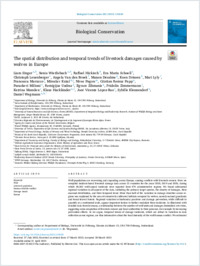The spatial distribution and temporal trends of livestock damages caused by wolves in Europe
DOKPE
- Singer, Liam University of Fribourg
- Wietlisbach, Xenia University of Fribourg
- Hickisch, Raffael EuroLargeCarnivores, Austria
- Schoell, Eva Maria University of Natural Resources and Life Sciences, Vienna (BOKU)
- Leuenberger, Christoph University of Fribourg
- Van den Broek, Angela BIJ12, Leidseveer 2, 3511 SB Utrecht, the Netherlands
- Désalme, Manon Direction Régionale de l'Environnement, de l'Aménagement et du Logement d'Auvergne-Rhône-Alpes, France
- Driesen, Koen Agency for nature and forests of the Flemish Government, Belgium
- Lyly, Mari Finnish Wildlife Agency, Kampusranta 9C, FI-60320, Seinäjoki, Finland
- Marucco, Francesca University of Torino
- Kutal, Miroslav Mendel University in Brno
- Pagon, Nives Slovenia Forest Service, Večna pot 2, SI-1000 Ljubljana, Slovenia
- Papp, Cristian Remus Babeş-Bolyai University
- Milioni, Paraskevi Hellenic Agricultural Insurances Organization, Greek Ministry of Agriculture and Food, Greece
- Uzdras, Remigijus State Service for Protected Areas under the Ministry of Environment, Antakalnio g. 25, LT-10312 Vilnius, Lithuania
- Zihmanis, Ilgvars State Forest Service of Latvia, 13. janvāra iela 15, LV-1932, Latvia
- Zimmermann, Fridolin Stiftung KORA, Talgut-Zentrum 5, 3063 Ittigen, Switzerland
- Marsden, Katrina Adelphi consult GmbH, Alt-Moabit 91, 10559 Berlin
- Hackländer, Klaus University of Natural Resources and Life Sciences, Vienna (BOKU)
- López-Bao, José Vicente Oviedo University
- Klenzendorf, Sybille WWF Germany, Reinhardtstr. 18, 10117 Berlin, Germany
- Wegmann, Daniel University of Fribourg
- 21.04.2023
Published in:
- Biological Conservation. - Elsevier BV. - 2023, vol. 282, p. 110039
Nature and Landscape Conservation
Ecology
Evolution
Behavior and Systematics
Wolf
Livestock predation
Human–wildlife conflict
Damage trends
Europe
English
Wolf populations are recovering and expanding across Europe, causing conflicts with livestock owners. Here we compiled incident-based livestock damage data across 21 countries for the years 2018, 2019 and 2020, during which 39,262 wolf-caused incidents were reported from 470 administrative regions. We found substantial regional variation in all aspects of the data, including the primary target species, the density of damages, their seasonal distribution, and their temporal trend. More than half of the variation in damage densities across regions was explained by the area of extensively cultivated habitats occupied by wolves, namely natural grasslands
and broad-leaved forests. Regional variation in husbandry practices and damage prevention, while difficult to quantify at a continental scale, appear important factors to further modulate these incidents. As illustrated with detailed data from Germany, a relationship between the number of wolf units and damages diminished over time, suggesting some adaptation of livestock owners and local authorities to their presence, for example by increasing prevention efforts. As we argue, temporal trends of damage incidents, which are robust to variation in data collection across regions, are thus informative about the local intensity of the wolf-human conflict. We estimated increasing trends for the majority of regions, reflecting the current expansion of wolves across the continent. Nonetheless, many of these increases were moderate and for more than one third of all regions, trends were negative despite growing wolf populations, thus indicating that wolf-livestock conflicts can be successfully mitigated with proper management.
and broad-leaved forests. Regional variation in husbandry practices and damage prevention, while difficult to quantify at a continental scale, appear important factors to further modulate these incidents. As illustrated with detailed data from Germany, a relationship between the number of wolf units and damages diminished over time, suggesting some adaptation of livestock owners and local authorities to their presence, for example by increasing prevention efforts. As we argue, temporal trends of damage incidents, which are robust to variation in data collection across regions, are thus informative about the local intensity of the wolf-human conflict. We estimated increasing trends for the majority of regions, reflecting the current expansion of wolves across the continent. Nonetheless, many of these increases were moderate and for more than one third of all regions, trends were negative despite growing wolf populations, thus indicating that wolf-livestock conflicts can be successfully mitigated with proper management.
- Faculty
- Faculté des sciences et de médecine
- Department
- Département de Biologie
- Language
-
- English
- Classification
- Biological sciences
- License
- Open access status
- hybrid
- Identifiers
-
- DOI 10.1016/j.biocon.2023.110039
- ISSN 0006-3207
- Persistent URL
- https://folia.unifr.ch/unifr/documents/324698
Other files
Statistics
Document views: 122
File downloads:
- singer2023_0: 111
- wolf_supplementary_information_final: 80

